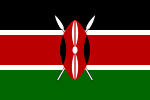This article has multiple issues. Please help improve it or discuss these issues on the talk page. (Learn how and when to remove these messages)
|
| Total population | |
|---|---|
| 157,787[1] | |
| Regions with significant populations | |
| Languages | |
| Kisuba • Kiswahili | |
| Religion | |
| African Traditional Religion • Christianity | |
| Related ethnic groups | |
| Luhya, Bagisu, Suba-Simbiti |
| Part of a series on the |
| Culture of Kenya |
|---|
 |
| Cuisine |
The Suba (Abasuba) are a heterogeneous Bantu group of people in Kenya with an amalgamation of clans drawn from their main tribes Ganda people, Luhya people, and Soga who speak the Suba language that is closely similar to the Ganda language spare some lexical items borrowed from Luo.[2][3] Their population is estimated at 157,787, with substantial fluent speakers. They migrated to Kenya from Uganda and settled on the two Lake Victoria islands of Rusinga and Mfangano, others also settled on the mainland areas including Gembe, Gwassi, Kaksingri of Suba South and Migori and are believed to be the last tribe to have settled in Kenya[citation needed]. The immigrants to present-day Subaland trace their ancestry among Ganda people, Luhya people, Soga people, and the Luo people. The evidence supporting this is the fact that some Suba groups speak languages similar to Luganda, Lusoga and the Luhya. The Suba groups tracing ancestry among the Kenyan tribes preceded those groups from Uganda in present-day Subaland and are the numerous and influential ones. Those groups from Uganda are mostly concentrated in Rusinga and Mfangano islands with small pockets of them being found in mainland Kenya. Linguistically, the Suba are highly influenced by the neighbouring Luo, to the point of a language shift having taken place among large portions of the mainland Suba. As a result, their own language has been classified as endangered.[4] Despite this language shift, the Suba have kept a distinct ethnic identity. The Rusinga Festival is held in December of every year as a cultural festival to celebrate and preserve Suba culture and language.[5]
A community cultural festival known as Rusinga Island Cultural, Religious and Arts Festival popularly known as RICRAF is an annual community event which celebrates the cultural heritage of the indigenous Abasuba peoples of Rusinga Island, celebrates the island's archeological significance and gives the islanders a platform to showcase cultural arts and industry.
The Abagirango (Suna Girango) is another group that is usually erroneously grouped together with the Abasuba of Suba South and Suba North, since they also call themselves Abasuba. But, this is because Girango had a son named Musuba (Suba) and this Musuba had many children than his other brothers, for instance, Tegi and Gire hence descendants of Musuba calling themselves Abasuba meaning Musuba's people. Suba clans in Suna include Simbete, Sweta, and Wiga; and they have a clear and distinct ancestry that goes back to forefathers who crossed red Sea from Misri as illustrated below:
Ragwe<--Siora<--Montheya<--Girango<--Musubaabs
Their language is also distinct and very different from the Olusuba language spoken by the Abasuba of Homa Bay County. The Suna people speak the Ekisuba/Egesuba language which is the same language spoken by their brothers the Suba people (Tanzania). Currently, those who claim to speak Ekisuba actually speak igikuria (bunchari dialect) which is the same language as the Ekisuba/Egesuba spare the name difference.
- ^ "2019 Kenya Population and Housing Census Volume IV: Distribution of Population by Socio-Economic Characteristics". Kenya National Bureau of Statistics. Retrieved 24 March 2020.
- ^ Ayot, H. Okello (1979). A History of the Luo-Abasuba of Western Kenya: From A.D. 1760-1940. Kenya Literature Bureau.
- ^ Jenkins, Dr. Orville Boyd. "The Suba of Kenya and Tanzania -- A Cultural Profile". strategyleader.org. Retrieved 21 January 2018.
- ^ Centre, UNESCO World Heritage. "The Mfangano-Rusinga Island Complex - UNESCO World Heritage Centre". whc.unesco.org. Retrieved 21 January 2018.
- ^ "Rusinga festival sets island alight - PHOTOS". Daily Nation. Retrieved 21 January 2018.